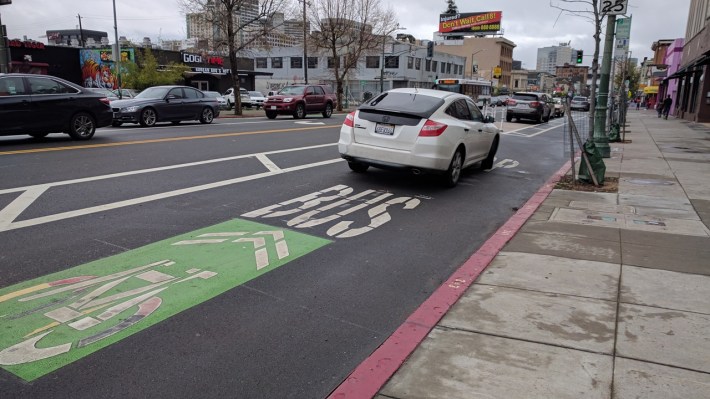Nine months isn't a long time to create a Department of Transportation (DOT) for the City of Oakland.
But that's exactly what Jeffrey Tumlin, Principal and Director of Strategy at NelsonNygaard Consulting, was tasked with last July. Next week, Tumlin's service as director of the department he has now created comes to an end. He will be replaced by Ryan Russo, who hails from New York's DOT. So yesterday evening Tumlin sat down with Ratna Amin of the San Francisco Bay Area Planning and Urban Research Association (SPUR) at its Oakland location to reflect on the past nine months, what he's learned, and what he hopes to see for the future of Oakland's new transportation department.
Amin started out the conversation by going over the definition of an exit interview: a talk about what the employee learned while at the job, both good and bad, and how those lessons can be passed along.

Tumlin started by talking about the long hours involved. "I love being interim director...reorganizations are traumatic, particularly in the public sector and I don’t want to gloss over how tough it’s been to create this department." He said that other cities who have watched the changes in Oakland should think very hard about trying to create their own DOTs. "It’s really important to know why...don’t do it just because the other kids are doing it."
So why did Oakland do it?
"First we had to decide 'what is it for?' One thing a transportation department is not for is solving the congestion problem." Tumlin said there's a conventional wisdom among citizens and politicians to assume a DOT is about widening roads and increasing traffic flow. "Widening roads works for about five minutes, until people ask 'why not move to the bigger house five minutes farther away?'" he explained. The result is more road surface to maintain, more congestion, and more pollution.
In fact, as tons of data and experience in cities all over the world has proven, there is no way to prevent rush-hour traffic jams. "Capital investment in transportation, whether it is about widening roads or adding BART lines, has no effective impact on congestion," he explained. But that doesn't mean a DOT can't have a positive and important impact on society--if one keeps in mind transportation isn't, first and foremost, about transportation.
Instead, he said it's important to think about it in terms of economics and other benefits. For example, "People in healthcare say transportation has more impact on health than the health industry does." Tumlin said healthcare providers deal with problems, such as heart disease and diabetes, after these conditions are already acute. "A resident in deep East or West Oakland...we knock ten years off their lifespan because of pollution and transportation investment and because we have denied them the opportunity to walk and bike."
"By the same token, if we make a street more joyful and more interesting, we get in our 10,000 steps in every day, and we can enhance public health," he said. He talked about how exercise releases oxytocin--and how, in fact, exercise, such as taking a bike ride or a walk, makes people happier.
Furthermore, "we kill or severely maim about 140 people a year in Oakland," said Tumlin. "That's human error combined with bad design."
Tumlin said he set up the DOT to look at these values and metrics, so that it enhances health and equity, not the traditional "level of service" of getting more cars through a given intersection. But that was more about collecting data and setting up the right administrative structures, not--for the most part--visioning pretty streets.
He summed it up nicely in a Tweet that made the rounds among transportation folks last month:
Successful public agency mgmt formula:
— Jeffrey Tumlin 🏳️🌈 (@jeffreytumlin) March 21, 2017
60% removing obstacles for staff
20% budgeting
15% time management
10% labor relations
5% vision
So how does one remove obstacles for staff? Tumlin stressed that the key is getting good data and being able to respond to it. What does that look like in practice, asked Amin? She brought up the Telegraph parking-protected bike lane as an example (see lead photo). As Streetsblog readers will recall, this lane in downtown--the first of its kind in the Bay Area--was built over the objections of many merchants.
Tumlin said they did a report to find out exactly what was happening on the street. Sarah Fine, one of Oakland's DOT staffers, put together the “Telegraph Avenue Progress Report” (PDF). It showed, as expected, that the project got more people cycling. But there were also surprises. "The number of pedestrians doubled. Crashes decreased by 40 percent. We eliminated crosswalk crashes for pedestrians," he said. It also found that merchants, thanks to all the increased pedestrian traffic, were seeing more sales--debunking the myth that reducing car lanes harms retail. "That enables us to deal with the story telling that project opponents put forward that 'nobody ever goes to telegraph anymore,'" said Tumlin.
But he also said there were problems and it's key to acknowledge and deal with them. Buses now have to shuffle across the parking lane and the bike lane to get to the curb to pick up passengers. This has created delays in bus service. But Tumlin said they are working on a solution. "We’re trying to accelerate completion of the bus boarding islands that will allow the buses to avoid that merge problem." Tumlin seemed confident this will make bus service even better than it was before the Telegraph project was implemented. "This is part of admitting when we haven’t fulfilled our obligations and identifying what needs to be done... So always collect the data, hear the complaints, and work diligently to correct those."

Amin wondered if the experience on Telegraph will "...change the conversation on the next project?"
Tumlin said it would. "People are like, oh, okay, this will be like that project. We’ll do one of those. It’s also really powerful for our staff and policy makers." But, again, he stressed the importance of having data. "Most of us are rightfully afraid of change because so much can be lost. Data can help us see when our investments are doing what we hoped and recognize when...we need to make a correction."
As another example, the data showed that the changes on Telegraph, despite eliminating a car lane, have not actually decreased the number of cars that pass through--it's merely stopped them from speeding from red light to red light. So now Tumlin can counter the naysayers with: "We’re terribly sorry you can’t drive 20 mph over the speed limit anymore."
Tumlin, acknowledged, however, that when it comes to making changes, it was easier for him to take risks than a typical public official. "I’m fearless. I’m the interim director. If they fire me, I go back to my cushy private sector job where I work half as many hours and get paid more."
Oakland will welcome DOT director Russo next week.

For more events like these, visit SPUR’s events page.






